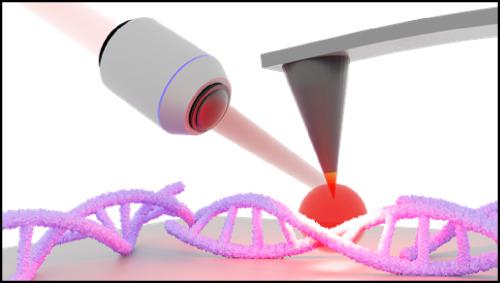当前位置:
X-MOL 学术
›
J. Raman Spectrosc.
›
论文详情
Our official English website, www.x-mol.net, welcomes your feedback! (Note: you will need to create a separate account there.)
A comparison of gold and silver nanocones and geometry optimisation for tip‐enhanced microscopy
Journal of Raman Spectroscopy ( IF 2.5 ) Pub Date : 2020-09-14 , DOI: 10.1002/jrs.5987 Luke R. McCourt 1 , Michael G. Ruppert 1 , Ben S. Routley 1 , Sathish C. Indirathankam 2 , Andrew F. Fleming 1
Journal of Raman Spectroscopy ( IF 2.5 ) Pub Date : 2020-09-14 , DOI: 10.1002/jrs.5987 Luke R. McCourt 1 , Michael G. Ruppert 1 , Ben S. Routley 1 , Sathish C. Indirathankam 2 , Andrew F. Fleming 1
Affiliation

|
Correspondence Luke McCourt, School of Electrical Engineering and Computer Science, The University of Newcastle, Newcastle, New South Wales, 2308, Australia. Email: Luke.Mccourt@uon.edu.au Abstract In this article, boundary element method simulations are used to optimise the geometry of silver and gold nanocone probes to maximise the localised electric field enhancement and tune the near-field resonance wavelength. These objectives are expected to maximise the sensitivity of tip-enhanced Raman microscopes. Similar studies have used limited parameter sets or used a performance metric other than localised electric field enhancement. In this article, the optical responses for a range of nanocone geometries are simulated for excitation wavelengths ranging from 400 to 1000 nm. Performance is evaluated by measuring the electric field enhancement at the sample surface with a resonant illumination wavelength. These results are then used to determine empirical models and derive optimal nanocone geometries for a particular illumination wavelength and tip material. This article concludes that gold nanocones are expected to provide similar performance to silver nanocones at red and nearinfrared wavelengths, which is consistent with other results in the literature. In this article, 633 nm is determined to be the shortest usable illumination wavelength for gold nanocones. Below this limit, silver nanocones will provide superior enhancement. The use of gold nanocone probes is expected to dramatically improve probe lifetime, which is currently measured in hours for silver coated probes. Furthermore, the elimination of passivation coatings is expected to enable smaller probe radii and improved topographical resolution.
中文翻译:

金和银纳米锥的比较和尖端增强显微镜的几何优化
通讯作者 Luke McCourt,纽卡斯尔大学电气工程与计算机科学学院,纽卡斯尔,新南威尔士,2308,澳大利亚。电子邮件:Luke.Mccourt@uon.edu.au 摘要 在本文中,边界元法模拟用于优化银和金纳米锥探针的几何形状,以最大化局部电场增强并调整近场共振波长。这些物镜有望最大限度地提高尖端增强拉曼显微镜的灵敏度。类似的研究使用了有限的参数集或使用了局部电场增强以外的性能度量。在本文中,针对 400 到 1000 nm 的激发波长模拟了一系列纳米锥几何形状的光学响应。通过测量具有共振照明波长的样品表面的电场增强来评估性能。然后将这些结果用于确定经验模型并为特定照明波长和尖端材料推导出最佳纳米锥几何形状。本文得出的结论是,金纳米锥有望在红色和近红外波长提供与银纳米锥相似的性能,这与文献中的其他结果一致。在本文中,633 nm 被确定为金纳米锥的最短可用照明波长。低于此限制,银纳米锥将提供卓越的增强。金纳米锥探针的使用有望显着提高探针寿命,目前镀银探针的寿命以小时为单位。此外,
更新日期:2020-09-14
中文翻译:

金和银纳米锥的比较和尖端增强显微镜的几何优化
通讯作者 Luke McCourt,纽卡斯尔大学电气工程与计算机科学学院,纽卡斯尔,新南威尔士,2308,澳大利亚。电子邮件:Luke.Mccourt@uon.edu.au 摘要 在本文中,边界元法模拟用于优化银和金纳米锥探针的几何形状,以最大化局部电场增强并调整近场共振波长。这些物镜有望最大限度地提高尖端增强拉曼显微镜的灵敏度。类似的研究使用了有限的参数集或使用了局部电场增强以外的性能度量。在本文中,针对 400 到 1000 nm 的激发波长模拟了一系列纳米锥几何形状的光学响应。通过测量具有共振照明波长的样品表面的电场增强来评估性能。然后将这些结果用于确定经验模型并为特定照明波长和尖端材料推导出最佳纳米锥几何形状。本文得出的结论是,金纳米锥有望在红色和近红外波长提供与银纳米锥相似的性能,这与文献中的其他结果一致。在本文中,633 nm 被确定为金纳米锥的最短可用照明波长。低于此限制,银纳米锥将提供卓越的增强。金纳米锥探针的使用有望显着提高探针寿命,目前镀银探针的寿命以小时为单位。此外,



























 京公网安备 11010802027423号
京公网安备 11010802027423号